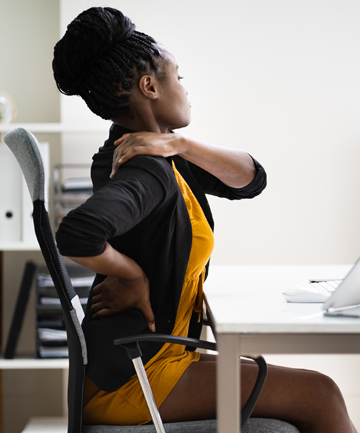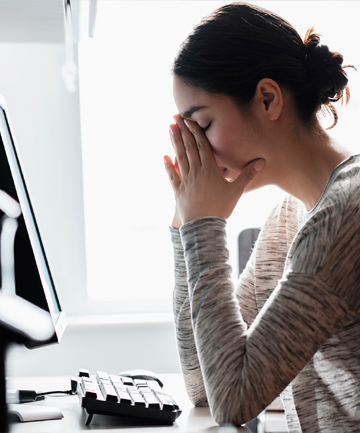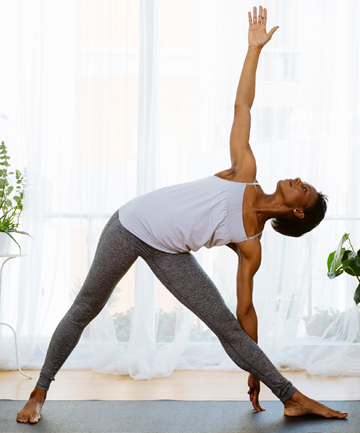Pandemic posture is a real thing and its contributing factors are more multifaceted than you think. On the whole, we're exercising less frequently due to gym closures, which is an issue in and of itself. Less exercise means reduced mobility and flexibility. Also, because we're not as active, we're spending way more time on couches and in front of screens, which can impact our posture as well.
"In addition, a good portion of the country was/is working from home in less than ergonomically correct situations causing them to be hunched over computer screens or laptops," explains spinal surgeon Dr. Gbolahan Okubadejo. "All of these factors have led to poor posture brought on by various factors of the pandemic."
Image via AndreyPopov/iStock/Getty Images Plus/Getty
One of the major clues you're dealing with poor posture is if your body is hurting or feeling uncomfortable. You may be dealing with lower back pain, a stiff neck or shoulders, headaches as well as numbness or tingling in your arms and hands notes Lauren Jenai, founder of CrossFit and new health and fitness app Manifest.
She goes on to say that you may also look a bit different if your neck isn't properly aligned with the rest of your spine. This includes rounded backs, slouched shoulders, a head that leans forward or the formation of wrinkles/lines on your neck aka tech neck.
"Poor posture also deprives oxygen from your body and brain. When you slump, your brain, heart and lungs cannot function efficiently," Okubadejo points out. "Also, [poor posture] weakens bones and muscles resulting in pain and injury. Every time you lean over even 60 degrees, whether over your phone, the computer or a good book, you're adding up to 60 pounds of pressure on your neck."
Image via Cecilie_Arcurs/E+/Getty
The correlation may not seem obvious, but poor posture can ultimately impact your mental well-being. Not feeling good physically can affect your general mindset. "Poor posture can result in increased stress, potentially leading to chronic stress," notes Okubadejo. "Correct posture in the face of adversity maintains self-esteem and elevates mood."
Image via JGI/Tom Grill/Getty
There's an interesting issue that occurs once we start feeling off due to poor posture. Whether it's fatigue, tight shoulders or headaches, we are naturally inclined to baby ourselves and skip workouts. This is the opposite of what we ought to do, according to Okubadejo.
"This makes the back muscles tighten even more. What you should be doing instead is swimming (if possible), doing light yoga and core strengthening exercises. The only time people should stop exercising is if they have been to a spinal surgeon/orthopedist and have been directed to do so or if the pain when exercising is so excruciating that it makes exercise impossible. The latter is a telltale sign that you need to see a doctor."
Image via Westend61/Getty
Now that you know what signs to look for, let's address how to fix the problem. The core of the issue (no pun intended) is the way you're sitting while working or relaxing.
"When we recline in our seats with no support for the lower back and our legs resting on another surface, it creates a curve in the lumbar region of the spine that causes fluid to move to the posterior of the intervertebral discs. This position can apply undue pressure on those discs," explains Okubadejo. "The muscles of the neck and shoulders then have to work twice as hard to keep the head upright, which eventually leads to discomfort and tension in those muscle groups."
The bottom line is that sustaining this type of laid-back posture will cause a weakening of the back and abdominal muscles, affecting your core and triggering back pain. The lower back is also compromised because the thighs are not adequately supported and this causes strain.
"The optimal position is to be seated at a 90-degree angle with your feet flat on the floor and your back supported by the back of a chair," advises Okubadejo. "This position represents appropriate alignment, but even this position sustained for hours can cause discomfort as our body is meant to move and take a break from a sedentary position."
The solution? Assume this sitting position when working, but make sure to take breaks once every hour. You can go on a quick walk around the block, tend to some other errands or simply stand around for a break. Another option is to use a standing/sitting desk, like this Flexispot desk, $249.99, which allows you to oscillate between both positions. You shouldn't stand all day either so a healthy mix is ideal.
Image via Science Photo Library/Getty









